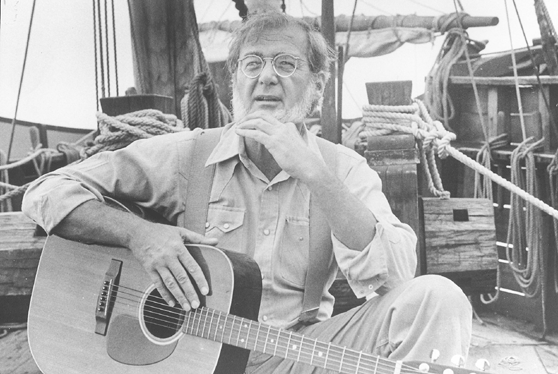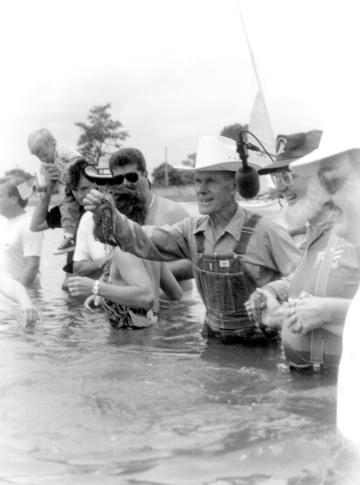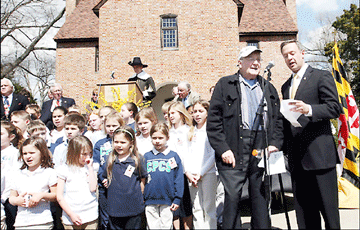
Volume XVII, Issue 23 # June 4 - June 1, 2009 |
 |
|
|
 Chesapeake Born, Chesapeake Free and Chesapeake Bound
Chesapeake Born, Chesapeake Free and Chesapeake Bound
Dying, Bay Bard Tom Wisner keeps working to waken our souls
by Sara Ebenreck Leeland
When the news hit the Bay region late last fall that Maryland’s Tom Wisner, writer and singer of “Chesapeake Born,” had aggressive lung cancer, community response was immediate.
Reporters and film folk checked in at Tom’s Solomon’s-area farmhouse. Headlines broadcast his life achievements. Friends grieved, then started figuring out how to support his stated intention: “to live this reality of dying.”
For Tom, that means sticking to his creative process. He starts the day singing his songs, singing their world into being, himself in it. As chemotherapy brought down the scope of the cancer, his energy rose. He went to work on unfinished songs, then set his sights higher: getting out two CDs of unrecorded music and archiving his lifework for public access.
Creativity must be healing, since in early spring doctors reported that his immune system was kicking in.
Tom’s spirit rose high. One e-mail shows the depth and detail of his revived involvement in the world: “Cussed little microtus the mouse got into the live trap and I’ll have to drive him/her away today to a new home. A large old groundhog came to visit by the porch last evening.”
The CDs and songbook are moving, he reports; so is work on the Smithsonian Folkways music-archive and the Chestory archive of Chesapeake waterfolk lore at the Calvert Marine Museum. A friend, he said, videotaped the movements that go with his “Freedom Is a River” song, “to encourage singing and motion with disabled folks.”
This is the man who’s in treatment for advanced lung cancer? Yes, but this is also a man compelled to create and share both work and vision with the world around him.
The Roots of Tom’s Vision
Tom’s courage to follow his path as a freelance Chesapeake educator, artist and singer was a radical choice, but one clearly signaled earlier in his life. He’d started art school in Washington, D.C., before volunteering for the Air Force in the Korean conflict. Once home, he married, then used veterans’ benefits support to get a college degree and scholarship to the graduate biology program at Cornell University. Thinking back, Tom says that he loved drawing critters and “thought that meant he’d love biology.” At Cornell, he excelled at the science but fed his soul by painting New York people and places.
|
|
![]() While he waited for a faculty member to clear space for advising his thesis research, Tom came to Southern Maryland to teach, then went on to work at the Chesapeake Biological Laboratory. There he created a stunning experience-oriented children’s laboratory and educational program, and he reached out to any public groups or schools that asked. Encouraged by Bio Lab director Gene Cronin, Tom got out on the skipjacks with Chesapeake watermen, learned their rich traditions of song and story, then recorded their memories and tales. Endlessly he photographed and drew, making Bay visuals for programs.
While he waited for a faculty member to clear space for advising his thesis research, Tom came to Southern Maryland to teach, then went on to work at the Chesapeake Biological Laboratory. There he created a stunning experience-oriented children’s laboratory and educational program, and he reached out to any public groups or schools that asked. Encouraged by Bio Lab director Gene Cronin, Tom got out on the skipjacks with Chesapeake watermen, learned their rich traditions of song and story, then recorded their memories and tales. Endlessly he photographed and drew, making Bay visuals for programs.
On the side, Tom strummed his guitar, feeling his way into the earliest of his Chesapeake songs. For two summer weeks, he helped run a Bethany Beach program that used dance, art and voice to help young people deepen their experience of community. His goals kept opening up: doing Chesapeake education that would join science with the arts, personal growth with learning.
When director Cronin left Chesapeake Biological Laboratory in the late 1970s, Tom was asked to shift toward public relations. Some years back, his marriage had dissolved, as had daily links with his children. So the “Chesapeake ecologist with hope and a guitar,” as scientist-friend Joseph Mihursky called him, cut loose from the laboratory.
He founded the Tom Wisner Studio, home for the newly roving educator, singer and artist of the Chesapeake.
Roving Ecologist-Educator-Artist
Tom and son Mark Wisner, joined by singer Teresa Whitaker, put their songs on the now-classic made-in-the-living room 1979 recording, “Chesapeake Born.” With support from area libraries, Tom created a tri-county series of events focused on the waterway heritage of Southern Maryland. He was off and running.
It takes deep file-cabinet drawers filled with decades of clippings to chronicle Wisner events around Chesapeake Country. An entire wall in his home shows the framed awards for his work. A children’s song album, Come Full Circle, emerged in 1984. That’s the album that advised young singer, Jessica Boynton, “You’d better watch the songs you sing; they make you who you are!”
Tom believes that. His own songs had become like mantras from which, he says, he kept learning. “Hey there wild river, teach me your song” focused a deep inner need to listen to the rivers and the land they ran through as a way to learn about them and our form of civilization. He waded into a springtime river with Chief Turkey Tayak of the Southern Maryland Piscataway, began thinking about river rituals that could help us realize the plight of our waterways and persuaded Senator Bernie Fowler to do a Patuxent River Wade-in. That ritual took off across Bay Country. The song made a second appearance on his 2000 CD Made of Water.
When Tom found the writings of cultural historian Tom Berry in the 1990s, he quoted them over and over, in workshops and on stage. “The universe is not a collection of objects to be exploited; it is a communion of subjects to be revered,” wrote Berry.
What if we did see land- and waterscapes not as out there to look at, but as living realities in which we are fully participants? Our lives would change, Tom thinks. He knows and practices that way of seeing.
Sitting with Tom out in his sunflower garden as he sings with a Carolina wren, it’s obvious that he’s playing in a conversation with sound and pauses, meanings that escape words. It’s pure Wisner.
|
|
For Which Many Are Grateful
So: How does he live knowing that time is limited?
He faces it openly and lets friends into the story.
Participation has always been essential to Tom’s work. He dates it back to the feelings he had as a kid visiting his Uncle Luther down in James River country. In summer, folks gathered on Luther’s front porch to tell stories and sing; in winter, they gathered around the pot-bellied stove in Luther’s general store. The warm feelings in those gatherings beat “perfect performance” any time for Tom.
Friends, old and very new, are with Tom now.
In the waning days of fall, former EPA scientist Kent Mountford came to sail Tom up the Patuxent River. Bay writer Tom Horton arrives regularly to share tales of Bay creatures and folk. Estuarine biologist Walter Boynton stops by with stories about the comedy of life, an exchange with a 30-plus-year history. Musicians Frank Schwartz and Teresa Whitaker, John Cronin and Mack Walter — all of whom have performed with Tom — come to help get unrecorded songs on track for the two new CDs. Jokes, good talk and warmth go ’round.
Maryland poet laureate Michael Glaser comes to conjure up a stir-fry lunch. At one such meal, Glaser remarked that every room of Tom’s home — walls covered with drawings, beloved Bay paintings, pictures of friends, events and family — was a working museum in itself. The Smithsonian music archive folk picked up on the thought, filming room after room.
Glaser pushed the state to make Tom’s song “Maryland, My Maryland” a second official song. That didn’t happen, but the Wiz carried his song to Maryland’s 375th birthday celebration and roped “the fine Irish tenor’ Gov. Martin O’Malley into singing with him. The Gov. then asked Tom and friends, including Michael and Kathy Glaser, up for dinner with songs and stories in Annapolis. Kathy, an educator, is working on a Wisner Chesapeake song book.
Quieter gifts arrive. A son and daughter come; the other children call. A friend picks Tom up for the hard trips in which chemo solutions drip into his body. A doctor provides expert care, and writes off some of the bill. A local attorney donates time to get Tom’s will in place, then tells Tom he wishes he’d made some choices like Tom’s to live closer to the longings of his soul. Sue Kullen, the delegate who campaigned to make Tom’s song official, revives his energy with Aunt Hope’s peanut-butter fudge.
As early summer opens down on old Jake Soller’s place, where Tom lives, the Wiz is still singing. (Jake’s the well-educated tobacco farmer who named his dog Man, focus of Tom’s song “Southern Maryland River Country Way.”) The Wiz has just written a new song, about Maryland’s Old Line, the Revolutionary Army men who held off the British on Long Island while Washington’s main forces got safely away.
|
|
 Let Us Honor Tom Wisner
Let Us Honor Tom Wisner
About to mark his 79th birthday this month, Tom Wisner’s still teaching us all, modeling a creative, interactive-with-the-earth-community way to live.
For all this, let us honor Tom Wisner. Want to let him know you care? Do the old-fashioned thing and mail him a note at P.O. Box 705, Solomons, MD 20688.
For early recordings, contact Smithsonian Folkways on-line. For current and coming music, go to www.chestory.org and press contact to send a message so you’ll be contacted when CDs come out.
Then hum one of his Chesapeake songs. Let it become part of your life. It’ll change who you are!



